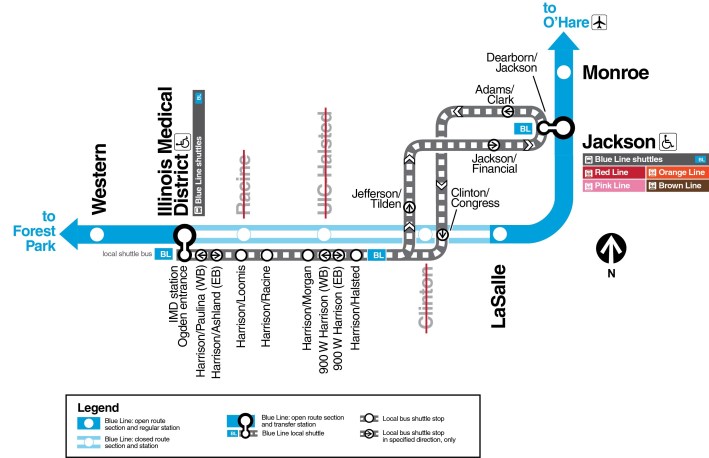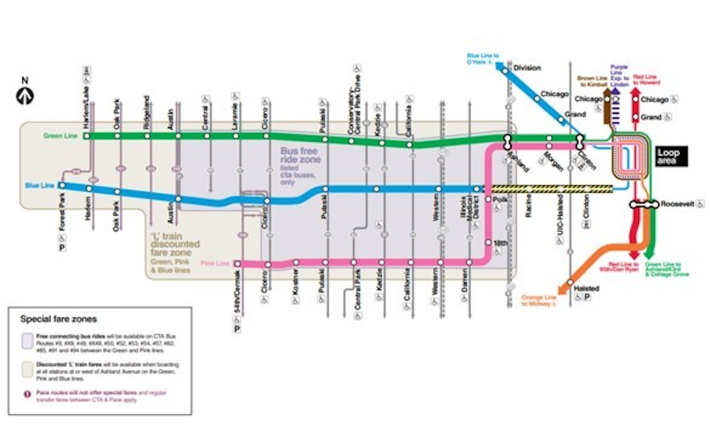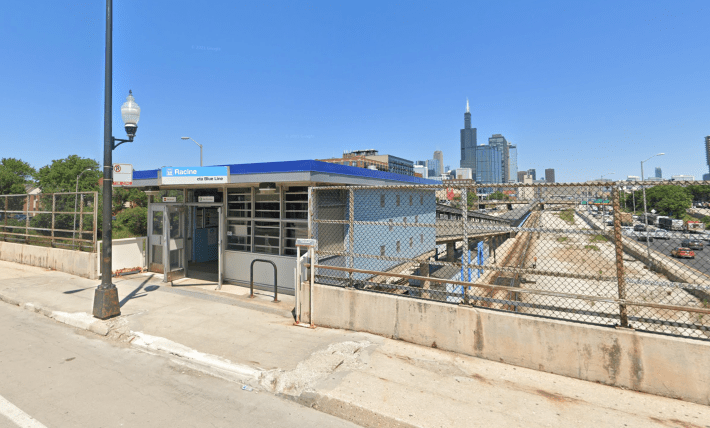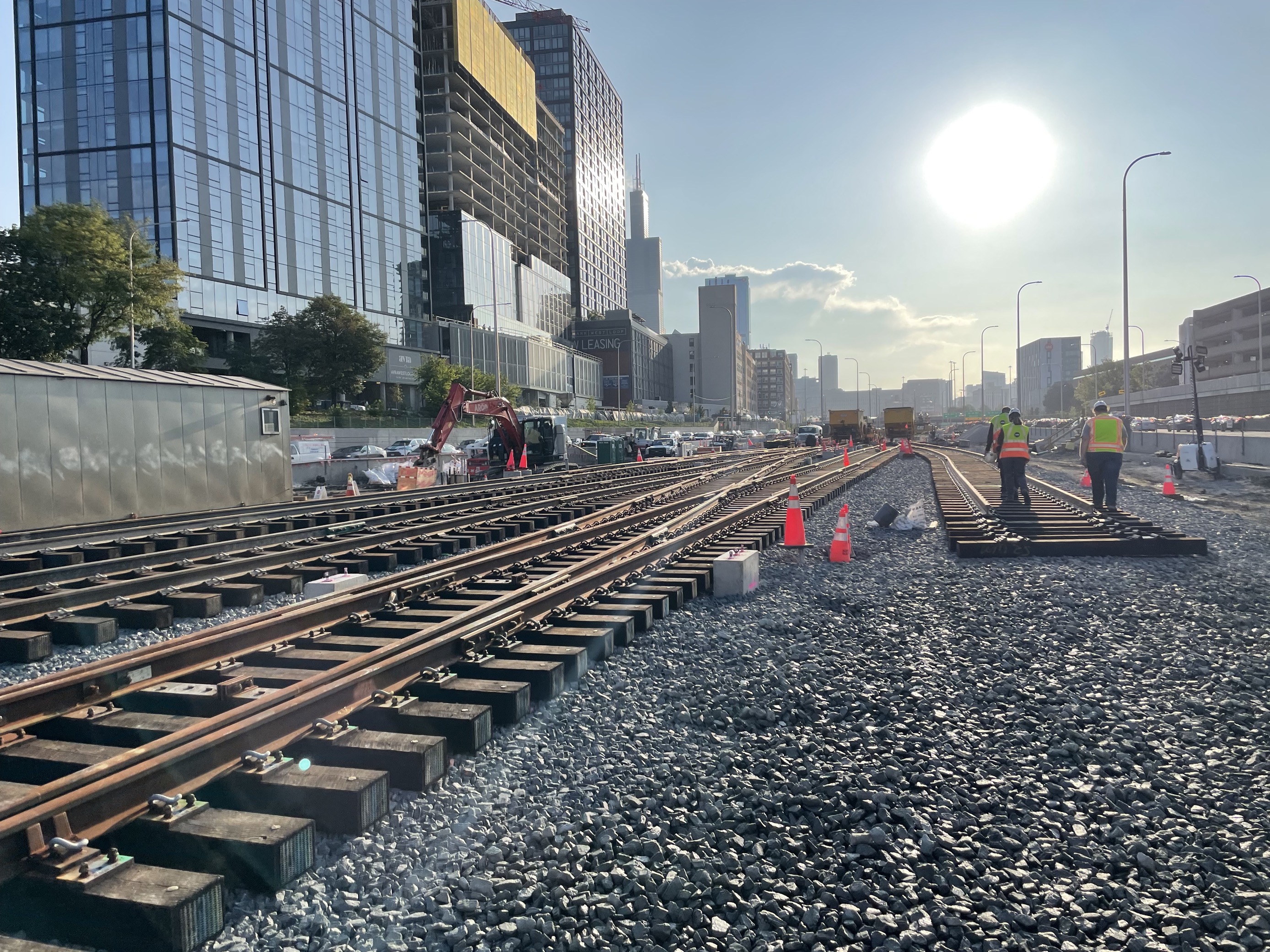
There was some good news from the CTA last Thursday, September 21. The transit agency announced that its $268 million project to upgrade the Forest Park Branch of the Blue Line between the LaSalle (130 W.) and Illinois Medical District (1900 W.) stations, which started on July 23, will largely wrap up on Sunday, October 8. That's when normal Blue Line operations will resume, just in time for the Chicago Marathon later that day.
But before then, Blue Line riders, who've been dealing with various service disruptions while 15,000 feet of track has been replaced and the Racine (1200 W.) station has been rebuilt, have one more hiccup to handle. On August 20, Blue Line trains resumed serving the Clinton (530 W.) and UIC-Halsted (800 W.) stations via the new tracks. However, in what the latest CTA press release calls "a critical step in completing project work on time" those stations will close again from Friday, September 29 at 10 p.m. through Monday, October 2 at 4 a.m.
Meanwhile, the grassroots advocacy group Commuters Take Action (CTAction), which supports the reconstruction but has critiqued many aspects of the project, has more criticisms of the next steps. First let's look at what the agency had to say about the last couple of weeks of work on this section of the Blue Line between LaSalle and IMD, dubbed Phase 1.
How the rest of Phase 1 will work
Currently the Blue Line is running in two segments, between the Forest Park station and the Illinois Medical District (1900 W.), and between the Clinton and O'Hare stops. There's 24/7 shuttle bus service covering the roughly mile-long stretch between UIC-Halsted and IMD.

But during the upcoming weekend closures of UIC-Halsted and Clinton, the trains to and from O'Hare will revert to only running as far as LaSalle (130 W.) station, as was the case in the early weeks of Phase 1, which was dubbed Part A. As such, the shuttles will once again operate 24/7 between the IMD and Jackson (300 S., located on Dearborn Avenue, 30 W.) stops.

"Due to the street-to-mezzanine elevator at the Adams-Jackson entrance undergoing maintenance, riders who require an accessible path will be directed to the Jackson station complex and shuttles on Dearborn via the pedway to/from an elevator on State," the new release states. "CTA signs will be posted throughout the station and along the street level pathway to guide riders." (We'll have more discussion of this accessibility issue in a bit.)
At 4 a.m. on Monday, October 2, service is supposed to return to its current Part B rail gap between IMD and UIC-Halsted, until that gap is permanently eliminated in time for the marathon on Sunday, October 8.
For all the rest of Phase 1, including the weekend closure, the difficulties for riders will be eased somewhat through the free bus and reduced rail fare zones that have existed previously during the project. Read about how that works here.

When the track work wraps up on October 8, you'll be able to access the Racine station's platform via its Loomis (1400 W.) auxiliary entrance. The main entrance two blocks east is expected to stay closed until late 2024. When it reopens, the Loomis entrance will close for a rebuild until 2025.

Was the upcoming weekend closure planned?
So was closing UIC/Halsted and Clinton again at the end of this month part the original Blue Line Branch plan? It wasn't mentioned in last month's press release. Or did something unexpected come up to require this?
A CTA media representative told Streetsblog this service change is needed to tie the new tracks from Part A (LaSalle to UIC-Halsted) and Part B (UIC-Halsted to IMD) together. "As part of the Phase 1 project, we were able to reopen the tracks between LaSalle and UIC by late August, minimizing the disruption to riders as much as possible, while continuing our aggressive round-the-clock construction schedule to resume normal Blue Line service before the marathon. In short, this was not unexpected, and we’re happy to continue to share that the project is on time and on budget."
Commuters Take Action responds
"Commuters Take Action is looking forward to the end of this project and increased speeds throughout the corridor," said member Brandon McFadden in response to a query from Streetsblog. Still, he said his organization has a few issues with how the project is progressing.
"We remain concerned about the post-project service intervals," McFadden said. "There has been little communication from the CTA about the October 8th schedule changes.This date is also when we anticipate the release of updated systemwide schedules."

The CTA cut Blue Line service by 14 percent, according to data from the CTA's General Transit Feed Specification public data website. McFadden said that while 8 trains per hour are currently scheduled on the route, data shows that the average for the branch is 6 trains per hour in each direction, with very unreliable arrival times.
"Riders regularly report crowded trains and extensive waits during the morning and evening peak periods," McFadden said. "With schedule cuts looming, we can’t see how this could get anything but worse."
Commuters Take Action is also unhappy about the CTA plan for access to the shuttle buses from the Jackson Blue Line station during the upcoming weekend station closures for people who can't use stairs. After arriving by train to the Blue stop, they'll have to take an elevator down to the transfer tunnel, travel a block east to the Red Jackson station, take elevators to the street, and travel another block west to catch the bus, and vice-versa.

"As the closures next week were anticipated, the CTA should have made more effort to ensure a safer and more directly accessible route," McFadden said. "This added transfer time will cause riders requiring an accessible path to miss the shuttle buses that depart after the train arrives."
Finally, according to McFadden, even when trains have been running between LaSalle and UIC-Halsted during Part B, the CTA Train Tracker has not provided time estimates for this segment. "This leaves riders to guess whether a train is coming. We hope the final stages of the project go smoother than the earlier ones."
Indeed, here's hoping that the last couple weeks of Phase 1 go without a hitch so marathon participants – and everyone else in Chicago – can enjoy smoother, faster Blue Line trips come October 8.

Did you appreciate this post? Please consider making a tax-deductible donation.




